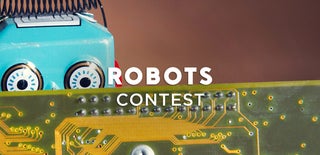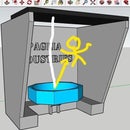Introduction: E.S.D.U (Emergency Service Droid Unit)
Today, we are going to be building an E.S.D.U (Emergency Service Droid Unit). The E.S.D.U is broken down into 3 classes: Police, Fire, and Medic.
All of these are not yet fully developed, but I hope we can upgrade and develop them together as a community. Therefore, this project will be completely open source.
E.S.D.U Purpose:
The main purpose of the E.S.D.U is to help people and keep them safe.
For example, the Police Unit will be programmed to guard a certain area and trigger deterrents such as alarms when motion is detected.
The Fire Unit will be programmed to watch over a certain area and if it detects a massive heat signature (a fire) it will extinguish it using a fire extinguisher gun that is equipped to it.
The Medic Unit will sound an alarm (to get help) or call 911 if it detects a drop in vitals (the droid will detect the vital signs through a bracelet that the patient wears that monitors their vitals like this), and will also be able to remind its patient to take their medicine at certain times, and much more.
Though, you don't have to build these droids to serve those purposes. You can build these droids to use as robot butlers, guard robots, or even robots to show off. Ultimately, you get to decide what your robots purpose will be and how to use them. Don't forget to have fun with this project, and be sure to share how you intend to use this robot (I'd love to hear about it). Now, let's get started!
Supplies
(x6) 1kg PLA
Servo Motors
Various Sensors
An Ardunio
6004-2RS 20x42x12 mm ball bearings
Step 1: Building the Torso
In order to start the E.S.D.U you must first print all the parts, which can be found here on Thingiverse..
We will be starting with the torso first.
Refer to the images above for assembly instructions.
Notes:
Before attaching anything to the torso servo, you must set it to 90 degrees.
Insert a bearing into the Torso Rotate, then push the Servo Axle through.
Bolt the servo down into L-Torso and R-Torso.
Attach a Servo Axle Nut to the Servo Axle and glue or melt it to the Torso Rotate to ensure that they spin together.
Step 2: Attaching the Torso to the Chest
Refer to the images above for assembly.
Notes:
Assemble the Back and Chest parts as shown.
The Torso Rotate fits into the slot on the Back and it also fits into the groove on the Chest.
Melt/Weld or glue the Torso Rotate to the Back & Chest to ensure that they spin together.
If you printed Chest-1 & Chest-2 Blank you must weld or glue those two together then weld/glue the Torso Rotate to it. Please keep in mind that there is no groove there so you must weld/glue it to the Chest as straight and as level as possible.
Step 3: Adding the Neck and Shoulders
Refer to the images above for assembly help.
Notes
Weld/Glue the two Neck Pieces together, then slide them into the rail on the Back.
Attach the Shoulders by using the Shoulder Aligner to help you align the shoulders (the aligner goes through the shoulder holes and the top chest holes). Then weld/glue the shoulder in place once everything is aligned.
You can adjust the height of the neck by sliding up/down the rails. Once you have your desired poition, you can either glue it or screw it in place. (You may have to sand the rails down to make the neck slide in).
Step 4: Adding the Head and Ears
Refer to the images above for assembly.
Notes:
Insert a servo into the Neck's servo slot (Don't forget to set your servo to 90 degrees).
Assemble the two Ear Pieces together. You can use the Ear Aligner to help align them. Once you have it all aligned you can weld/glue them together. You can use the Ear Aligner to attach the ears to the head. The Ear Aligner will go through the ear hole and the head hole on the side.
Attach the Face Plate to the Back Head by press fitting or sliding it on. (You may need to sand the rails down in order for the Face Plate to slide on).
Attach the servo horn to your servo and bolt the horn to the head (make sure it is center with the bottom head hole (the small one). You can refer to the image showing the servo and the drawn-in black square. That is where the servo horn should go).
Step 5: Adding the Bicep
Refer to the images above for assembly.
Notes:
Set right shoulder servo (the servo that goes into the shoulder) to 0 degrees and left shoulder servo to 180. Do the same with the forearm servo (Forearm should be pointing straight down. If you are going by the pictures and notice that the Forearm is pointing outwards and you want to start there, you must set the servo to 90 degrees).
If the servo is on the right side it should be set to 0 degrees, and if it's on the left it should be set to 180. For the rotate servo (the servo that goes into to Bicep-1 and allows Bicep-2 to rotate) you must set it to 90 degrees.
Insert a bearing where ever you see a bearing groove (refer to picture that says "Bearing goes here" to see what the bearing groove looks like).
Bolt the servo horn to the Servo Axle and insert in through the bearing. For Bicep-1, you must screw the Servo Axle Nut on and weld/glue it to Bicep-1 to ensure that they rotate together.
For the forearm, insert a servo into Bicep-2's servo slot and screw the servo horn to the Forearm. Then insert a bearing into the bearing slot and push the Servo Axle through the Forearm hole and the bearing hole. This will allow the Forearm to stay level and balanced.
Repeat these steps for the other side.
Step 6: The Legs
Please keep in mind that the legs have not yet been tested.
The Leg assembly is very similar to the Bicep assembly. In fact, they're basically the same , minus the whole rotate servo part.
Please refer to the images above for assembly.
Step 7: Enjoy
Now that you have built the body you can add various sensors and use an Arduino to program it to do whatever you desire.
Enjoy!

Participated in the
Robots Contest











